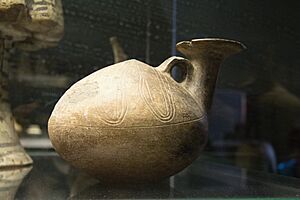Phylakopi facts for kids
Phylakopi (pronounced Fee-la-koh-PEE) was an important ancient city on the northern coast of Milos island. It was a major settlement during the Bronze Age, a time when people started using bronze tools. This city is special because people lived there for a very long time, from about 2500 BC to 1100 BC. This long history helps experts learn a lot about the different periods of the Bronze Age in the Aegean region, especially in the Cyclades islands.
Contents
Discovering Phylakopi

Archaeologists first started digging at Phylakopi between 1896 and 1899. The British School at Athens led these early digs and all the ones that followed. The way they dug was very advanced for its time. They carefully recorded where everything was found, layer by layer. This helped them understand the history of the site.
These digs showed that Phylakopi was a settlement that lasted throughout the entire Bronze Age. It helped experts understand the different stages of the Bronze Age in the Cyclades. Later, more digs happened in 1910–11 to learn more about the pottery found there. More recently, Professor Colin Renfrew led new excavations. These digs even found a hidden ancient temple, called a Sanctuary.
Life in the Bronze Age
The very first people to live at Phylakopi built a small village right on the natural rock. Their pottery was similar to other early Bronze Age groups, like the Grotta-Pelos culture.
Phylakopi I: Early Settlement
The first main period of the city, called Phylakopi I (around 2300-2000 BC), saw the settlement grow a lot. This was from the middle of the Early Bronze Age to the middle of the Middle Bronze Age. During this time, the city became bigger and more important. Some experts believe that the Phylakopi I culture was influenced by other cultures nearby.
Phylakopi II: A Flourishing City
During the second period, Phylakopi II (around 2000-1550 BC), the city truly thrived. It became a very important place in the Cyclades. Phylakopi II was a busy city with many houses close together, separated by long, straight streets.
This period is known for its beautiful pottery. Artists made pots with stylish plant and animal designs using black and red paint. The most famous items were "bird jugs" from Milos, which were even sent to Knossos on Crete. Towards the end of this time, more pottery from the Minoan civilization started appearing. This showed that Minoan culture was becoming more popular in Phylakopi.
Phylakopi III: New Influences
The city of Phylakopi III (around 1550-1100 BC) was built after the complete destruction of Phylakopi II. This destruction was probably caused by an earthquake. This period can be divided into three smaller parts.
In the first part of Phylakopi III, Minoan styles became very popular. Buildings like the 'Pillar Room' were built with large stone blocks. Inside, there was a well-preserved painting of a beautiful flying fish. Another building, called the 'Mansion', was likely an important office for the city. A piece of a Linear A tablet, an ancient writing system, was found there. The city also built a strong wall around itself during this time.
The pottery and buildings from this period show a strong Minoan influence. Some people think that the Minoans might have even controlled Phylakopi politically. Minoan ideas and culture were seen as very fancy and important by the rich people in the Aegean.
The Thera Volcano Eruption
In the second part of Phylakopi III, the Minoan influence became less strong. This happened after the huge eruption of the Thera (Santorini) volcano around 1500 BC. There aren't many clear building remains from this time, but a lot of pottery was found. This is when pottery from the Mycenaean civilization first started to appear.
Mycenaean influence became even stronger in the third part of Phylakopi III. A large hall called a megaron was built, which was common in Mycenaean palaces on the Greek mainland. A temple with Mycenaean statues was also found. A new strong wall was built, and Mycenaean pottery became very common, almost replacing the local Cycladic styles. Because of the megaron, some experts believe that the Mycenaeans might have taken over and ruled the city.
The End of Phylakopi
The city was abandoned at the end of the Late Bronze Age and was never lived in again. Today, the sea has worn away a large part of the ancient city.
See also
- Phylakopi I culture
- History of the Cyclades
- Cycladic art
- Goulandris Museum of Cycladic Art
- Archaeological Museum of Milos



